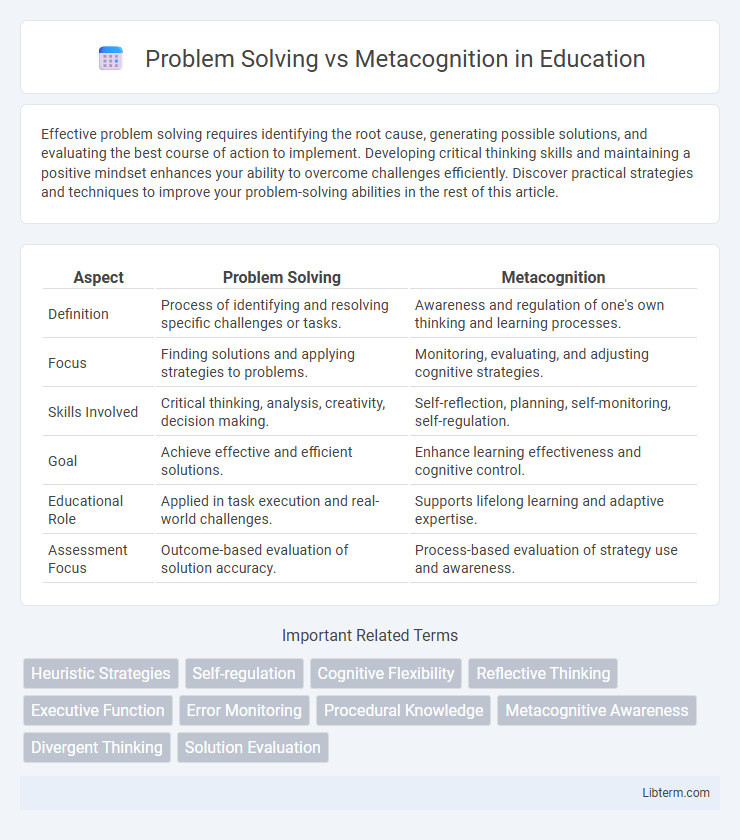Effective problem solving requires identifying the root cause, generating possible solutions, and evaluating the best course of action to implement. Developing critical thinking skills and maintaining a positive mindset enhances your ability to overcome challenges efficiently. Discover practical strategies and techniques to improve your problem-solving abilities in the rest of this article.
Table of Comparison
| Aspect | Problem Solving | Metacognition |
|---|---|---|
| Definition | Process of identifying and resolving specific challenges or tasks. | Awareness and regulation of one's own thinking and learning processes. |
| Focus | Finding solutions and applying strategies to problems. | Monitoring, evaluating, and adjusting cognitive strategies. |
| Skills Involved | Critical thinking, analysis, creativity, decision making. | Self-reflection, planning, self-monitoring, self-regulation. |
| Goal | Achieve effective and efficient solutions. | Enhance learning effectiveness and cognitive control. |
| Educational Role | Applied in task execution and real-world challenges. | Supports lifelong learning and adaptive expertise. |
| Assessment Focus | Outcome-based evaluation of solution accuracy. | Process-based evaluation of strategy use and awareness. |
Understanding Problem Solving: A Foundational Skill
Problem solving is a foundational skill that involves identifying challenges, analyzing information, and developing effective solutions. Metacognition enhances problem solving by enabling individuals to monitor their thinking processes, evaluate strategies, and adjust approaches for better outcomes. Understanding problem solving as a dynamic interaction between cognitive and metacognitive processes is essential for improving critical thinking and decision-making abilities.
Defining Metacognition: Thinking About Thinking
Metacognition involves the awareness and regulation of one's own cognitive processes, often described as "thinking about thinking." It enables individuals to plan, monitor, and evaluate their problem-solving strategies, leading to more effective and adaptive learning. By distinguishing metacognition from basic problem solving, educators can foster skills that improve self-reflection and strategic thinking in complex tasks.
Key Differences Between Problem Solving and Metacognition
Problem solving involves identifying, analyzing, and resolving specific challenges using logical and structured approaches, while metacognition refers to the awareness and regulation of one's own thinking processes during problem solving and learning. Key differences include that problem solving is an active process aimed at finding solutions, whereas metacognition encompasses self-monitoring, self-evaluation, and adaptive control over cognitive strategies. Metacognition enhances problem solving by enabling individuals to plan, monitor, and adjust their approach for improved effectiveness and learning outcomes.
How Problem Solving Skills Develop
Problem solving skills develop through iterative practice that engages both cognitive processes and metacognitive awareness, allowing individuals to plan, monitor, and evaluate their approach to complex tasks. Effective problem solvers routinely employ metacognitive strategies such as self-questioning and reflection to identify knowledge gaps and adjust tactics for improved outcomes. Research indicates that integrating metacognitive training into problem-solving exercises significantly enhances critical thinking, adaptability, and decision-making abilities across diverse contexts.
The Role of Metacognition in Learning
Metacognition plays a crucial role in learning by enabling learners to monitor, regulate, and evaluate their problem-solving strategies effectively. Through metacognitive awareness, students can identify when they do not understand a concept and adjust their approaches to improve comprehension and retention. This self-regulatory process enhances critical thinking and promotes deeper, more efficient learning outcomes.
Interplay: How Metacognition Enhances Problem Solving
Metacognition enhances problem solving by enabling individuals to monitor, evaluate, and adjust their cognitive processes during task execution, leading to more effective strategies and solutions. This self-awareness allows problem solvers to identify gaps in knowledge, anticipate potential obstacles, and manage resources efficiently, improving accuracy and efficiency. Research shows that metacognitive skills such as planning, self-monitoring, and self-reflection significantly boost problem-solving performance across various domains.
Common Barriers in Problem Solving and Metacognitive Awareness
Common barriers in problem solving include limited information processing, fixation on ineffective strategies, and emotional interference that impedes logical thinking. Metacognitive awareness enhances problem solving by enabling individuals to monitor their cognitive processes, adjust strategies, and recognize when understanding is insufficient. Deficits in metacognitive skills often result in poor self-regulation, leading to repeated errors and difficulty adapting to complex problem scenarios.
Strategies to Improve Problem Solving Abilities
Effective problem solving involves identifying the problem, generating potential solutions, and evaluating their outcomes, while metacognition enhances this process by promoting self-awareness and regulation of thinking strategies. To improve problem solving abilities, individuals can practice reflective thinking, set clear goals, and monitor their cognitive processes to adjust approaches as needed. Techniques such as breaking problems into smaller parts, seeking feedback, and employing analogical reasoning strengthen both problem solving and metacognitive skills.
Techniques for Cultivating Metacognitive Skills
Effective techniques for cultivating metacognitive skills include self-questioning, which encourages learners to evaluate their understanding and regulate their thought processes during problem solving. Reflective journaling helps individuals monitor their cognitive strategies, identify errors, and adjust approaches to enhance comprehension and efficiency. Implementing think-aloud protocols allows for real-time awareness of decision-making patterns, fostering improved planning, monitoring, and evaluation in complex problem-solving tasks.
Real-World Applications: Merging Problem Solving with Metacognition
Merging problem solving with metacognition enhances decision-making processes in real-world applications by encouraging self-awareness and strategy evaluation during complex tasks. Professionals in fields such as engineering, healthcare, and business leverage metacognitive techniques to monitor their problem-solving approaches, adapt strategies, and improve outcomes. This integrated approach fosters continuous learning and innovation, leading to more efficient and effective solutions in dynamic environments.
Problem Solving Infographic

 libterm.com
libterm.com